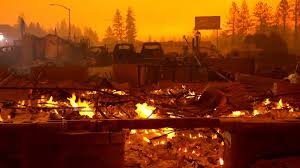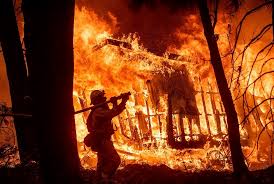Like an Invasive Species
- Written by Ronnell Hampton
- Jan 3, 2019
- 11 min read
Updated: Feb 2, 2019

In 2003 I was living in San Diego. That year there was the Cedar fire, which caused schools to shut down for almost a week due to air quality. Throughout the county, the Cedar Fire destroyed 280,278 acres, 2,820 buildings and killed fifteen people (The City of San Diego, 2003). It seems that since then, there has been a growing intensity to the wildfires experienced here in California. In 2018 California experienced one of the deadliest fire seasons in its history. Three fires, the Woosley, the Hills, and the Campfires, destroyed millions of dollars in property and killed nearly one-hundred people.
This week, Government Grilled cheese is going to talk about forest management and wildfire. First, we will discuss how indigenous people used fire for the sustainability of their communities and the forest eco-system. Second, we will look at how the United States movement west affected California indigenous peoples fire use and migration patterns, and the consequential outcomes this created for the ecosystem. Next, we will look at the infrastructure used by state and federal agencies to facilitate responses to fires in the urban and wildland forest settings. We will look at these agencies approaches to fire emergencies and look at the ways they facilitate their response. Lastly, we will look at how changes can be made that address a more just and efficient response and look at ways investments can be made toward holistic approaches to forest management that sees fire as a tool rather than a nemesis.
Sankofa
Before Europeans arrived in the Americas, indigenous peoples use of fire for forest management was widespread throughout the United States (Kay, 2000). In California, there are over one hundred federally recognized indigenous people tribes (Judicial Council of California, 2018). These tribes are from communities with history spread over California’s four geographical regional areas. These groups include the northern coastal group, the central valley and mountains group, the southern coastal group, and the desert group. Besides the desert region, each of these geographical areas have large landscapes of the forest. Throughout time, California indigenous people groups played a major role in managing these forest landscapes for the sustainability of the Indian communities and the environment. One of the main tools used for these management practices was prescribed fire burning. A fire was used to rid the forests of underbrush and clear roads to facilitate travel (Ecological Society of America, 2014). It enhanced plant production for berry-producing shrubs, oak trees, pine trees, and root crops. It was also an excellent insect pest control and was used to kill poisonous snakes and other vermin (Kay, 2000).
These fire-burning practices not only facilitated the sustenance needed for these indigenous tribes to thrive, but they also created a dynamic landscape. The roads and cleared prairies in the midst of the forest were a result of these consistent fire burning practices. As wildfires were a natural occurrence, the cultivated landscapes served as a buffer to stop a wildfire from gaining fuel and threatening life (Kay, 2000). These beautifully crafted landscapes and roads allowed indigenous communities to travel and establish farmland. The roads that were created also allowed the tribes to travel as needed based on weather conditions. For example, the mountain and central valley group created roads that allowed them to travel to the foothills of the mountains where it was cooler during the summer (Ecological Society of America, 2014). Ironically those roads also facilitate United States Settlers movement westward.
The Table
As more United States Settlers moved west, they impacted the indigenous people and the environment like an invasive species. Suppressive policies, population growth, and development, changed the environment and the way of life for the indigenous people (Lake, 2017). This invasion impacted forest management, interfered with indigenous people’s migration patterns, and changed the landscape. The development practices of the United States settlers were different from the practices of the indigenous people. Unlike indigenous populations, who built simple settlements and migrated to different parts of the landscape during different parts of the year, the United States settlers made stationary settlements in highly forested wildfire-prone areas (Berry, 2007). The challenge with this is that the United States settlers did not understand the impact their development was having on the environment (Lake, 2017). They did not understand that they had interrupted the necessary forest management practices of indigenous people, thus severely impacting the eco-system. The forest landscapes that the United States encountered did not occur naturally as originally assumed. These forest landscapes were a direct result of the way the indigenous people managed them (Bonnicksen 2000, Kay 1998).
The park-like features of the forest that appealed to the US were originally thought to occur naturally as a result of thunderstorm fire (Lake, 2017). The evidence did show that there were frequent low-intensity fires that structured many western forests. However, the assumption that the forest was created by lighting, which produced low-frequency high-intensity wildfire, was not supported by the historical data (Lake, 2017). The conditions in which lightning could cause a fire to occur, happen only early in the spring before leaf-out and understory regrowth, or late in the fall after leaf-drop and the understory has been killed by frost (Kay, 2000). This lightening theory was debunked when historical data showed that during both these period, there are few lightning strikes and virtually no lightning- started fires observed that supported their assumptions (Kay, 2000).
Fire is a part of the natural ecology of the forest. The indigenous people knew this and took the necessary precautions. The indigenous communities would either burn a clearing that would be less threatened by the fire or move to areas of the region during the wildfire season. The natural occurrence of fire would have been a non-issue for native people due to their fire burning and forest management practices. Indigenous communities would stagger burns by 5 to 10 years to craft beautiful mosaic forest landscapes. This added a lot of diversity in a small area within wildlands (Ecological Society of America, 2014). These carefully created patterns across the landscape gave indigenous communities access to different seral stages of soil and vegetation when tribes made their seasonal rounds (Ecological Society of America, 2014). Due to ignorance, the United State settlers developed permanent housing up against the backdrops of the forest without this consideration. As result, these stationary communities built within the forest landscapes have been threatened by the natural occurrence of fire (Berry, 2007). Rather than allow the ecology of wildfire to run its course, policies have been established that invest millions of dollars towards fire suppression.
Here and Now
Fire suppression policies have created negative effects on the natural ecology of wildfire. The policies have also created a barrier for native people that use fire burning for their sustenance. Although global warming plays a major role, the mismanagement of California’s forests by federal and state agencies through fire suppression policies, has created much of the fuel that causes the high-intensity wildfires that we are seeing today. Fire suppression causes vegetation changes that create a problem of invasive conifers or trees which act as easy fuel for wildfires (Kay, 2000).
The lack of prescribed and naturally occurring fire burning over the years has caused millions of acres of aspen to be lost to invading, fire-sensitive trees and plants (Kay, 2000). The ponderosa pine and Douglas fir (Pseudotsuga menziesii) forests are being replaced by more fire-sensitive, and more shade tolerant cone-bearing trees. Fire suppression is also affecting native grasslands which have declined rapidly while fire-sensitive, woody species have replaced them (Kay, 2000). California’s and Oregon’s Oak dominated communities are becoming endangered and are being replaced by their more fire-sensitive cousins (Kay, 2000). The hands-off or “natural-regulation” approach by today’s land managers is destroying the forest landscapes that indigenous people created over thousands of years.
It is important now more than ever before, to employ fire to manage the forest and understand the natural ecological process and value of wildfire. Infrastructure must be created to understand how we can live with and use fire rather than just suppress it. The urbanization of the forest caused by the United States movement west has resulted in an expansion of their socio-political systems in which the eco-system and indigenous people are caught in the crosshairs of. These systems create legislation that give incentives for fire suppression which has negatively affected the environment, indigenous peoples, and other marginalized groups.
There are two main agencies that facilitate fire policy and forest management in California. These agencies are Cal Fire, which is a State agency that manages thirty-one million acres of privately owned forest landscapes (Cal Fire, 2018), and Forest Service, which is a Federal agency that manages 193 million acres of forest landscapes (United States Department of Agriculture, 2018). Both of these agencies spend the majority of their budgets on fire suppression and prevention rather than taking a holistic fire management approach. Although many studies have shown the benefits of high-frequency, low-intensity burning for forest management (Lake, 2017), both agencies have little infrastructure that facilitates prescribed burning practices on an impactful scale, and their emergency response to wildfires is to put them out immediately.
Since 1905 The Forest Service has managed the national forest reserves. To set its self apart from rural farmers, and indigenous people who used fire as a means to manage the forest for agriculture, and other sustenance needs, the Forest Service established an antifire rhetoric (Berry, 2007). The most popular iteration of this is the Smokey the Bear mascot and slogan “only you can prevent forest fires.” This message was used to propagate the use of fire without a clear distinction of appropriate and inappropriate applications (Berry, 2007). In 1908 Congress passed the Forest Fires Emergency Act which allowed the Forest Service to put any available funds towards suppression. Later these expenses would be reimbursed by Congress (Berry, 2007). In 2018 this is the same process that is followed. Because of these polices the Forest Service takes an aggressive fire suppression approach in its forest management practices. On the Forest Service website, they tout the “accomplishment” that 98 percent of wildfires are suppressed within the first 24 hours they are detected(United States Department of Agriculture, 2018). In their 2018 budget over one-hundred million dollars was allocated towards fire suppression programs, while only 17 million dollars was put towards prescribed burning (United States Department of Agriculture, 2018).
Without adequate funding to find efficient holistic ways of forest management, The Forest Service has continued to focus on fire suppression. To continue their focus on fire suppression, money is being diverted from forest management personnel that focus on restoration projects which have been proven to reduce the risk of catastrophic wildfires (United States Department of Agriculture, 2018). Watershed projects that aim to protect drinking are being defunded in order to invest in fire suppression personnel. This focus on fire suppression is costing thousands of jobs and billions of dollars of economic activity while putting precious cultural resources and wildlife habitats at risk (Vilsack, 2015).
The state agency Cal Fire has a mission to safeguard the people and protect the property and resources of California (Cal Fire, 2018). Similar to The Forest Service, Cal Fire has a focus on fire suppression. Smokey The Bear is also the mascot of Cal Fire, and their approach to fire management is to immediately put out fires when they start (Cal Fire, 2018). A large part of this mission is dependent on exploited labor assistance from the California Department of Corrections. An interview done by Democracy Now during the November 2018 California fires showed how dangerous it is for the people fighting the wildfires. It also showed how dependent California is on the exploited labor from the California Department of Corrections. In the California fires during November 2018, 1,500 inmates fought alongside Cal Fire firefighters (Goodman, 2018). These inmates worked twenty-four-hour shifts for one dollar an hour.
Many would say that these inmates do not deserve to get paid more than one dollar an hour because they are incarcerated. The irony of this argument is that each person working a nine to five are protected by laws that guaranteed at least minimum wage. They also expect to get paid time and a half if they work over eight hours. Some employers also provide a minimum coverage of life insurance. If these are the minimum expectation of employment an individual has for employers in California, then it should be clear that the state of California is using exploitive labor practices to benefit from the work of inmates to facilitate the dangerous work of fire suppression.
Conclusion
As we look at ways to address better forest and fire management practices in our wildlands, and urban forest environments, we must be sure to develop policies that seek the most optimal solutions for all stakeholders involved. Current fire and forest management policies are wasting money while simultaneously interfering with indigenous people practices of fire burning, destroying the eco-system, and exploiting prison labor. In order to address this, several things can be done. First, these agencies can develop programs that fund inclusive well-paid land manager opportunities for indigenous people to reinstitute historical burning practices. The Forest Management Stewardship program allocates funds towards sustaining the local economy, however it does not explain how or if those funds directly translate to resources for indigenous communities on an impactful scale (United States Department of Agriculture, 2018). A more comprehensive stewardship program that aims for inclusivity for indigenous tribes are imperative to make this a reality. This is a way to provide restorative justice and a way to preserve/reestablish optimal vegetation conditions in parks and other natural areas.
There must also be a new outlook on the way fire is used. Currently, the Forest Service manages 193 million acres of forests. Over the last fifteen years, they have only applied prescribed burning to five percent of those lands (United States Department of Agriculture, 2018). Of the 31 million managed by Cal Fire, less than one percent receives prescribed burning per year (Cal Fire, 2018). Both of these organizations are failing to do their part of prescribed burning while pouring hundreds of millions of dollars into fire suppression which is adversely affecting the eco-systems. Money needs to be redirected from fire suppression into more holistic forest and fire management practices that includes widespread prescribed burning. Although prescribed burning benefits are well understood by both organizations these federal and state agencies are currently spending very little money on prescribed burning (United States Department of Agriculture, 2018) (Cal Fire, 2018).
Fires are becoming more intense and dangerous for the people fighting them. There needs to be more incentive for the inmates that fight these fires. For decades inmates have been paid about one dollar an hour to do the hardest work during the most dangerous fires in history (Goodman, 2018). While many of the Cal Fire firefighters are making close to six figures, the inmates can bbarely afford to send money home to help their families (Goodman, 2018). California saves hundreds of millions of dollars using inmate’s exploited labor to fight fires, while releasing some of these inmates with up to ten thousand dollars in owed restitution payments (California Department of Corrections and Rehabilitation, 2017). Any restitution owed by inmates participating in this program needs to be immediately canceled and a more just payment process needs to be developed. Each of these inmates should also receive a state funded life insurance policy of at least $100,000 that can be left for their family in case they die while fighting these wildfires.
It is imperative that our urban and wildland forest environment management processes be changed in order to be more equitable, sustainable and economically inclusive. Redirecting funding towards holistic approaches to forest management that address the neglect caused by a century of fire suppression policies is vital. There is no doubt that new infrastructure is needed to address the increasing threat to life and property. We must ensure that the new infrastructure also addresses the disenfranchisement of native people from being the stewards of their ancestral land, and the exploited labor practices of fire suppression. Thank you for tuning in to Government Grilled Cheese Find us on Facebook at Growing Greatness.
Works Cited
Berry, A. (2007). Forest Policy Up in Smoke: Fire Suppression in the United State. Retrieved from Property and Environment Research Center: https://www.perc.org/wp-content/uploads/2007/09/Forest_Policy_Up_in_Smoke.pdf
Cal Fire. (2018, 01 01). Benefits of Fire. Retrieved from Cal Fire: http://www.calfire.ca.gov/communications/downloads/fact_sheets/TheBenefitsofFire.pdf
Cal Fire. (2018, January 1). Fire and Emergency Response . Retrieved from Cal Fire: http://www.calfire.ca.gov/communications/downloads/fact_sheets/FireandEmergencyResponse.pdf
Cal Fire. (2018, January 1). Vegetation Management Program . Retrieved from Cal Fire: http://www.calfire.ca.gov/communications/downloads/fact_sheets/VegetationManagement.pdf
California Department of Corrections and Rehabilitation. (2017). Restitution Responsibilities, Information for Adult Offenders. Retrieved from California Department of Corrections and Rehabilitation: https://www.cdcr.ca.gov/Victim_Services/restitution_responsibilities.html
Ecological Society of America. (2014, July 26). Fire ecology manipulation by California native cultures . Retrieved from Science Daily: https://www.sciencedaily.com/releases/2014/07/140726082324.htm
Goodman, A. (2018, November 19). Meet the Prisoners Being Paid $1 an Hour to Battle the Deadly Climate-Fueled Fires of California. Retrieved from Democracy Now: https://www.democracynow.org/2018/11/19/meet_the_prisoners_being_paid_1
Judicial Council of California. (2018, 01 10). California Tribal Communities. Retrieved from California Courts: http://www.courts.ca.gov/3066.htm
Kay, C. E. (2000). Native Burning in Western North America: Implications for Hardwood Forest Management. Retrieved from fs.fed.us: https://www.fs.fed.us/ne/newtown_square/publications/technical_reports/pdfs/2000/274%20papers/kay274.pdf
Lake, F. (2017). Aracade.stanford.edu. Retrieved from Historical and Cultural Fires, Tribal Management and Research Issue in Northern California: Trails, Fires and Tribulations: https://arcade.stanford.edu/occasion/historical-and-cultural-fires-tribal-management-and-research-issue-northern-california
The City of San Diego. (2003). Fire Rescue Department. Retrieved from The City of San Diego: https://www.sandiego.gov/fire/about/majorfires/2003cedar
United States Department of Agriculture. (2018, 01 01). FY Budget Justification 2019. Retrieved from The Forest Service: https://www.fs.fed.us/sites/default/files/usfs-fy19-budget-justification.pdf
United States Dpeartment of Agriculture. (2018, 01 01). FY Budget Justification 2019. Retrieved from The Forest Service: https://www.fs.fed.us/sites/default/files/usfs-fy19-budget-justification.pdf
Vilsack, T. ( 2015, August 6). The Cost of Fighting Wildfires is Sapping Forest Service Budget . Retrieved from US Forest Service: https://www.fs.fed.us/blogs/cost-fighting-wildfires-sapping-forest-service-budget










Comments